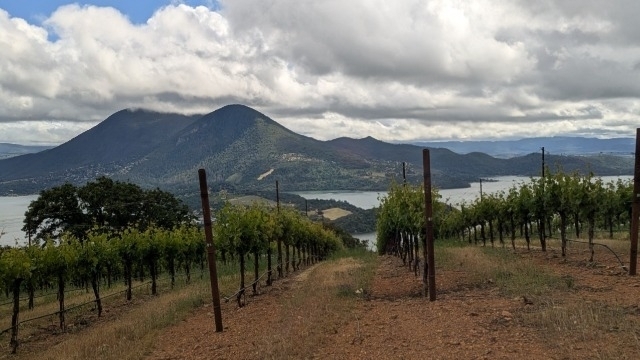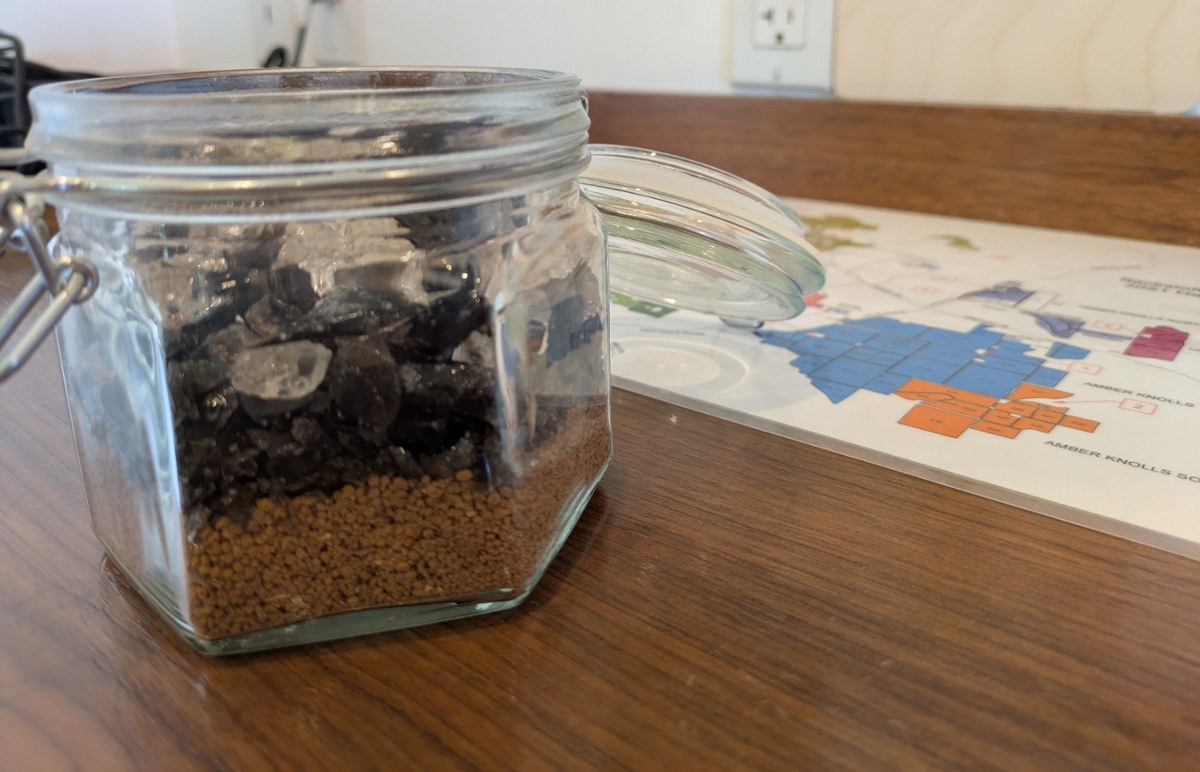
Perhaps unbeknownst to some, Lake County’s wine scene is bucking trends with the growth of its flagship varieties—Sauvignon Blanc and Cabernet Sauvignon—its authentic and warm “come as you are” attitude that draws visitors from both Napa and Sacramento regions, and its pioneering and collaborative spirit among vintners.
The County, which is tucked in Central Northern California between Sonoma, Napa, Mendocino and Yolo Counties, has just eight recognized appellations, some of which supply grapes to out of county wineries. Appellations include Clear Lake AVA, Big Valley District-Lake County AVA, Guenoc Valley AVA, High Valley AVA, Kelsey Bench-Lake County AVA, Red Hills Lake County AVA, Upper Lake Valley AVA and Long Valley-Lake County AVA.
With a bevy of geological features and soils—including semi-precious stones called Moon Tears, and franciscan and volcanic soils stemming from the 4,285-ft. Mt. Konocti and the surrounding lava domes and cinder cones—the first vineyards were planted in the 1870s, yet the region’s successful wine production was brought to a halt during prohibition.

It was brought back to life in the 1960s when plantings started again and wine industry luminaries such as Andy Beckstoffer planted Sauvignon Blanc, Cabernet Sauvignon and Malbec in 1997 in the Red Hills of Lake County (Beckstoffer has around 1,600 plantable acres across the county).
Currently Lake County is home to 30 wineries and other wineries/wine groups such as Constellation, Jackson Family Wines and Foley Family Wine & Spirits, own vineyards in the region.
“From less than 100 acres in 1965, vineyard acreage has grown to nearly 10,000 acres today and is expected to double in the next few years,” according to theLake County Winegrape Commission.
“It’s truly exciting to see Lake County winegrowing come into its own. For many years, growers have worked diligently to finetune farming in Lake County’s young volcanic soils, rugged topography, and high-elevation climate, and they have remained dedicated to producing quality fruit through sustainable, organic, and regenerative viticultural practices,” shared Debra Sommerfield, president, Lake County Winegrape Commission. “The result is mountain-grown grapes with excellent phenolics, tannins, structure, and balance – and winemakers across California have really come to appreciate the value Lake County grapes bring to their wine programs.”
While the volcanic soil of the region is well suited for Cabernet Sauvignon, the Big Valley AVA’s cool, dry air, afternoon breezes and proximity to Clear Lake create a great climate for Sauvignon Blanc which, when asked what variety the region could hang its hat on, Brassfield Estate Winery said is a key variety for the area.
Sauvignon Blanc of course continues to be a pretty strong leader in one of only a few growth areas of the total wine market. According to Nielsen data for the last 52 weeks ended April 19, 2025, Sauvignon Blanc has seen a 3.1% growth in sales value while other varieties are in a negative decline. Anecdotally, many in the wine industry have also recognized lighter whites and Sauv Blanc as outpacing other varieties such as Rose in the overall wine market.
At the Unified Wine & Grape Symposium in January, Jeff Bitter of Allied Grape Growers shared his analysis of what’s “hot” and what’s not. Essentially, whites are in and reds are out. He named interior Pinot Grigio, Sauvignon Blanc in various regions, and upper-end alternatives whites as “hot.” The “not” hot list includes traditional florals from the interior, and red grapes in general, especially Zinfandel anywhere in the state and generic reds, especially in the interior.
In March, Master Sommelier Evan Goldstein noted at the 12th annual Wine Conversations event that white wine is outpacing red wine and Rose and that bubbly “is on fire.”
Sauvignon Blanc is growing even more impressively at High Valley AVA-based Brassfield Estate, which was originally a cattle ranch and wildlife preserve purchased by Jerry Brassfield in 1973 (over the course of three decades, Brassfield acquired additional nearby properties and the estate now comprises over 5,000 acres).
“It’s bucking the trends in a huge way,” Chris Baker, president of Brassfield, said of the Sauvignon Blanc category.
Using SipSource data, Baker put together data from the last six months of the varietal category ending March 31, which he said showed that the Sauvignon Blanc category is down 1.31%, yet Brassfield’s Sauvignon Blanc is growing at 108%. The Cabernet Sauvignon category is down 7.8%, he said, yet their Cab is growing at 120%.
“Every varietal we have—with the exception of Rose, and that was by design—are growing in double to triple digits nationally,” he said.
Additionally, Brassfield uses various metrics for measuring growth including in case shipments; the raw number of cases that they shipped the previous year against what was shipped this year; current revenue versus last year’s; whether they increased revenue per case; and depletions by distribution network.
“Our case shipments are up 86% versus previous year. Part of that is driven by new markets that we’re opening up with this national alignment with Southern Glazer’s Wine & Spirits. And then our depletions are up 62%; same thing, we have more distributors than we had the previous year.”
He said their revenue is up 103% and they increased their per case revenue by 9% over what they were selling last year. Amid a time in the industry when sales are slumping, vineyards are being mothballed and younger consumers are drinking less, what is key to all this growth?
Baker—who came out of retirement to join Brassfield after a career at DAOU building it out to a successful Paso Robles brand and an eight-year stint helping build and grow the Lake County Shannon Ridge Family of Wines—attributed their success to having the right team and getting the brand story correct.
He said when he first came on board at Brassfield they had different pricing in different markets for the same SKUs. So they set out to get the pricing correct, hire the right people and gather the facts with Jerry and the executive team to tell a consistent brand story (they had inconsistent dates in the press on when the estate was purchased, when they initiated a crop study, when they broke ground on the winery etc.). Baker noted that it was about putting those elements together and a clear message that it is a 100% estate-grown, produced and bottled winery, which wasn’t the initial message that sales reps were using.
“With training, education and focus, that’s how we’ve been able to achieve this,” he said, giving credit to the team and reiterating that it’s about having the right team of people.
He added when you have authenticity and you’re rare in the world of wine where you’re one of the few that’s 100% estate-grown, produced and bottled and you have the uniqueness of being at elevation on a combination of volcanic and raised seabed soils, well, it’s a unique combination of elements.
“We really buck the trend where these big distributors, like Southern Glazers, weren’t taking new brands; as a matter of fact, they were culling a lot of brands out of their portfolio…. We were able to convince them that we were going to be a growth brand and they chose us as a 10-year partnership in all markets in the United States plus Canada, Latin America and the Caribbean,” Baker said. “I think it really comes down to authenticity, having the right price where we’re overdelivering on quality for the price point.”
In a nutshell, he encouraged authenticity, getting your brand story right, hiring the right people and being proud about what you have. And Lake County growers are certainly proud about the land they farm, many, like Shannon Ridge, choosing organic or regenerative farming methods to get the best out of the grapes while being gentle with the land. (Check out theMay 2023 issue of WineBusiness Monthly to view the trial that Shannon Ridge conducted with academics and researchers on sheep integration and soil health).
Baker said of the region: Here is pure, unspoiled land... “This is rare and the world needs to know about us.”
Not only is the region unique in that regard, but many of the wineries have an open and approachable atmosphere. At Wild Diamond Winery in Hidden Valley Lake, Calif., they often host barbeques and "moon tear" hunts for families to search for the diamond-like stones across their hilltop vineyards. At Shannon’s The Shannon Mercantile tasting room in Lakeport, it appeared there was something for everyone—a wide range of SKUS from crisp whites to bubbles and Bordeaux varieties, to family-friendly pizza nights and Taco Tuesdays to jump ropes and chalk for sale for young families who bring their kids.
This openness extends to the vintners and growers who often collaborate with each other with events such as the Lake County Pruning School, a project organized in 2022 by the Lake County Winegrape Commission with the help of Simonit & Sirch, a grapevine pruning school based in Europe that provides training in multiple languages and has notable clients such as Chateau Latour, Spottswoode, and among many others, Quintessa. The school teaches theory and practical pruning practices that foster grapevine health and resistance to pests, disease and drought.
“Growers here have a distinct combination of pioneering spirit and willingness to collaborate, so you find a lot of innovation, a lot of sharing of ideas, and a good camaraderie. You see this in the region’s programs like Lake County Pruning School, the first-of-its-kind with global pruning experts. In a region this small, it’s extremely rewarding to work together, building on each other’s successes.” Sommerfield noted.
